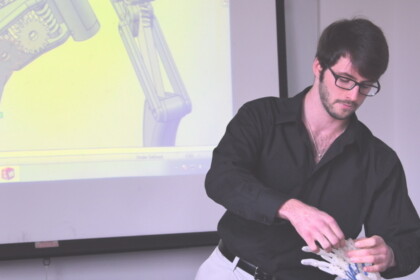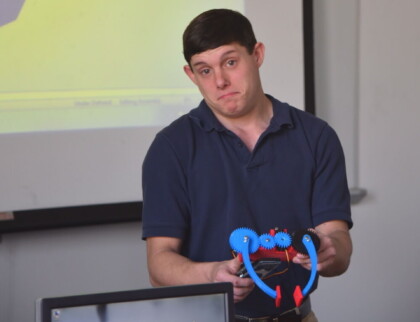
Projects & Materials

Building a Mechanical Hand

“I never thought about it before, but I take my own hands for granted,” said Liam Cross, reflecting on his experience building a model of a mechanical hand.
Liam is a Cape Cod Community College student who just completed ENR 102, 3D Mechanical Design 1, an introductory course for students interested in exploring careers as engineers, architects, and designers. Making a mechanical hand was final project for the course this past fall, and an amazing array of designs and different functionalities emerged from the students' work.

For Liam it was a way into the challenge of building prosthetics. Looking at his hands, he said, “When you step back and realize what these tools can do, it is incredible. To give somebody the ability to have those tools is a pretty powerful feeling.”
In the course, principles associated with 3D design, visualization, documentation, and product simulation are taught through hands-on use of Computer Aided Design (CAD) modeling software. Then, student-designed parts are fabricated in a 3D printer, giving them insights into the design-to-manufacturing process.
Professor Rick Bsharah points out that the coursework lays solid groundwork for each student's final project. First, for example, students had to develop their understanding of construction geometry. They needed the mathematics of axes, and revolutions in order to tackle their models.
At the same time, the course required them to apply, categorize, and justify the process steps of bringing their designs to life. The Students used Solidworks software and then created their final products on a 3D printer, which has heating element that melts plastic filament and then builds the final design in layers.
The students also spent time discussing ways mechanical hands might be used, one student had an idea about using them to defuse small explosive devices as a way to keep officers and civilians away from dangerous scenes. Another noted the relatively low cost of a mechanical prosthetics—while a prosthetic hand can cost $30,000, mechanical hands can be made for far less.
No matter what sort of hand they chose to make, the students said learning to work a CAD system and 3D printer taught them how to integrate principles of art, engineering, and design. And the final project gave them a sense of how those skills and tools could be applied in important ways.
“Imagine,” Liam said, “giving a small child the chance to hold a ball or his father’s hand.”